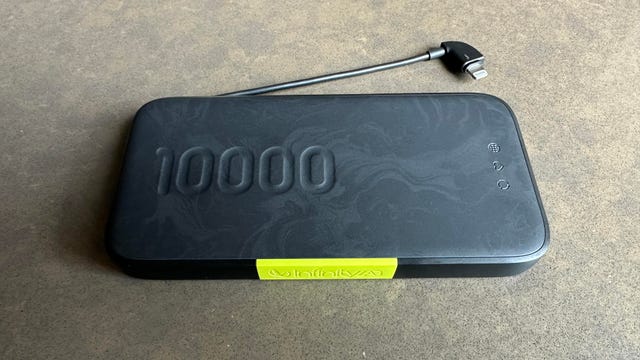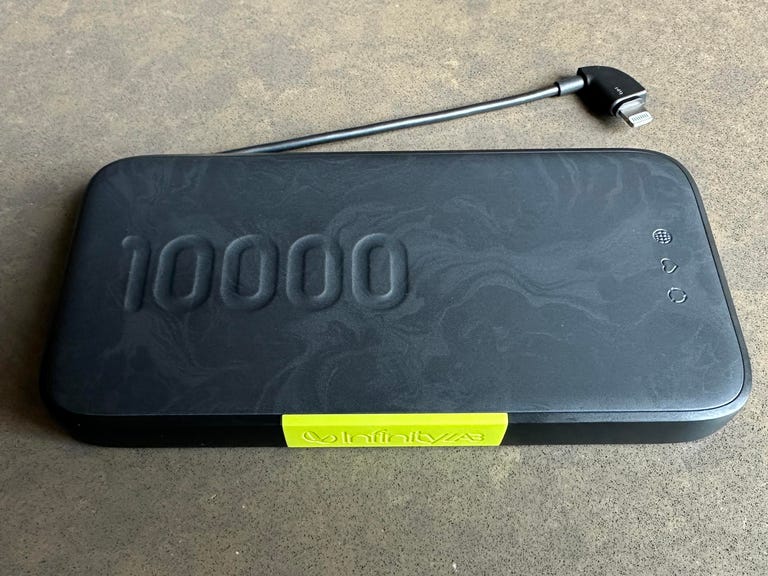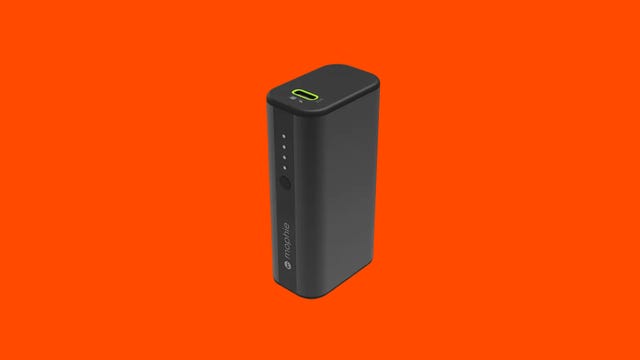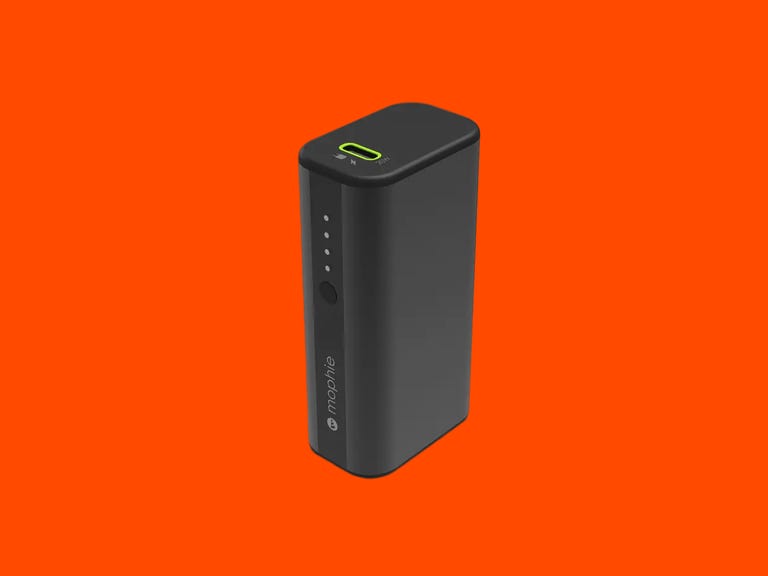Best magnetic power bank with integrated stand
Anker 622 MagGo magnetic battery
View details
Best value MagSafe-compatible power bank
Baseus Magnetic Mini Wireless Portable Charger
View details
Best compact power bank with foldable USB-C connector
Anker Nano Power Bank (USB-C)
View details
Top high-capacity power bank with integrated USB-C cable
Anker Nano Power Bank 10K
View details
Best power bank with integrated Lightning cable
Infinity Lab InstantGo 10000
View details
Best high-capacity magnetic wireless portable charger with flip-out kickstand
Baseus Magnetic Wireless Power Bank
View details
Best true MagSafe power bank not made by Apple
Mophie Powerstation 10K Stand with MagSafe
View details
Slim high-capacity battery with USB-C fast charging
Anker 523 PowerCore Slim 10K PD
View details
What’s the best power bank for the iPhone overall?
Power banks for iPhones are in a bit of a transition phase right now. While you’ll still find some power banks with an integrated Lighting cable, with the iPhone 15 series moving to USB-C, we expect to see more external batteries with integrated USB-C cables, which can also charge other USB-C equipped devices such as Android smartphones. Additionally, on the wireless charging front, companies like Anker and others are starting to release Qi2 power banks. They cost more but Qi2-certified wireless chargers offer 15-watt fast charging capabilities and are fully MagSafe compatible, offering twice the speed of standard 7.5-watt wireless chargers for MagSafe-enabled iPhone 13, 14 and 15 models and Android smartphones that support 15-watt wireless charging.
If we had to pick a single best iPhone power bank right now, it would probably be the Anker MagGo 622 or the new Qi2-certified Anker MagGo Power Bank 6.6K, which has an adjustable and foldable stand. Anker also released the higher capacity Qi2-certified MagGo Power Bank 10K with an integrated kickstand.
To be clear, nearly all of the models below will work with any recent iPhone — you’ll just need to make sure you have a charging cable that matches the ports on both sides (power bank and phone). On the wireless side, all Qi chargers will work with iPhones since the iPhone 8 and iPhone X lines, but chargers officially certified as MagSafe compliant will charge the phones faster and offer better feedback on the screen. Apple has yet to clarify if the forthcoming Qi2 chargers offer any additional benefits on the iPhone 15 line.
While we wait for newer models, here are our current picks. While this list is geared toward iPhones, any portable battery pack on the list with a USB-C or USB-A out ports will work perfectly well for charging an Android smartphone (or any other portable gadget), so long as you provide a compatible smartphone cable. Wireless (or inductive) charging should also work for Android phones that are so configured.
Read more: Best iPhone Chargers
Best power banks for iPhone for 2024
What’s cool about Anker’s 622 magnetic battery is that it’s a wireless battery that has an integrated magnetic flap that converts into a stand. You won’t get fast wireless charging from this 5,000-mAh battery (it charges at up to 7.5 watts), but it’s slim and easy to carry around.
It charges via USB-C, and if you use a USB-C to Lightning to charge your iPhone, it will charge at a faster rate of 12 watts. That’s not as fast as what a 20-watt USB-C power adapter can deliver, but it’s faster than 7.5 watts.
Note that Anker has updated this model to move the charging port to the side (from the bottom), so you can charge it while using it as a stand. That’s a worthy upgrade worth the $5 premium versus the
The Anker MagGo Power Bank 6.6K has a 6,600-mAh battery that can fully charge most iPhones one time. It’s Qi2-certified, which means it offers 15-watt fast charging capabilities and is fully MagSafe compatible, offering twice the speed of standard 7.5-watt wireless chargers for MagSafe-enabled iPhone 13, 14 and 15 models and Android smartphones that support 15-watt wireless charging.
Available in five color options, this model has a foldable design with customizable viewing angles. While it comes with a USB-C cable, you’ll need a USB-C charger with more than 15-watt output to hit those 15-watt charging speeds. You can take the power bank on the go or leave it plugged in to use as a wireless charging stand when at home. It’s fairly pricey at launch but will hopefully get some discounts as more competitors hit the market.
The Baseus Magnetic Mini Wireless Portable Charger is a compact, 6,000-mAh, wireless power bank that sticks to the back of MagSafe-enabled iPhones (or MagSafe-enabled iPhone cases) and charges your iPhone at 7.5 watts. If you’re looking for faster charging, you can plug a USB-C to Lightning cable into the battery and get 20-watt charging speeds. It also offers pass-through charging, meaning you can charge the battery while charging your phone.
The battery is similar in size to many 5,000-mAh batteries and also costs less. That 6,000-mAh capacity will get you close to a full charge with most iPhones, though it may fall a bit short for iPhone Pro Max models.
If you’re looking for a new power bank for your new USB-C equipped iPhone 15, Anker’s Nano Power Bank with an integrated foldable USB-C connector is an appealing choice — and it also charges Android devices (or anything with a USB-C charging port). It’s available in multiple color options.
This 5,000mAh power bank weighs in at 3.5 ounces, or 100 grams. It features 22.5W of fast charging power with the option to charge two devices at the same time if you plug a cable into the power bank’s USB-C in/out charging port. (Charging two devices simultaneously divides the charging power in half, delivering 11.25W to each device.)
MyCharge’s Hub portable chargers come in a few different sizes and not only have an integrated foldable wall plug but integrated Lightning and USB-C cables, so you can charge both Apple and Android devices. It’s a little bulky, but with a 6,700-mAh battery, it should be able to almost fully charge your smartphone, depending on its size. The step-up 10,050-mAh model is about $20 more.
If you’re looking for a beefier portable battery option, Anker’s 10,000-mAh Nano Power Bank is one of the better values out there, with an integrated USB-C cable. It’s not huge but it’s certainly on the larger side and can be used to charge multiple devices (along with the USB-C cable, there’s also USB-C and USB-A out ports). The battery charges your devices at up to 30W. I also appreciated the LCD that shows precisely how much battery life is available.
Infinity Lab is the new accessories subsidiary of Harman Kardon — a company that is, in turn, owned by Samsung. (Got that?) I like its InstantGo 5000 and InstantGo 10000 power banks, which come with an integrated Lightning cable for easy charging for iPhones (the InstantGo 5000 is currently sold out). The larger 10000 mAh costs more and is heavier. However, it can charge most iPhones twice. Both models are also well designed with a slightly grippy finish on the top and bottom of the battery.

Photo Gallery 1/1

David Carnoy/CNET
The Anker MagGo Power Bank 10K has a 10,000-mAh battery that can fully charge most iPhones around 1.75 times. It’s Qi2-certified, which means it offers 15-watt fast charging capabilities and is fully MagSafe compatible, offering twice the speed of standard 7.5-watt wireless chargers for MagSafe-enabled iPhone 13, 14 and 15 models and Android smartphones that support 15-watt wireless charging.
Available in five color options and not much bigger than the MagGo Power Bank 6.6K, this model has a retractable kickstand and an LCD that displays remaining battery life. While it comes with a USB-C cable, you’ll need a USB-C charger with more than 15-watt output to hit those 15-watt charging speeds. You can take the power bank on the go or leave it plugged in to use as a wireless charging stand when at home. Like the 6.6K version, it’s fairly pricey at launch but will hopefully get some discounts as more competitors hit the market. For those looking for a higher-capacity battery, the MagGo Power Bank 10K is probably a better choice than the MagGo Power Bank 6.6K. But I do like the foldable stand a little better on the Power Bank 6.6K.
If you’re looking for a bigger portable battery that charges your phone wirelessly, the Baseus Magnetic Wireless Power Bank is an excellent option. It houses a 10,000-mAh battery that can charge an iPhone 14 around two times — but it’s still somewhat compact.
The magnet is strong, and I also liked that it has an integrated flip-out kickstand, so it converts into a stand. There’s also an LED battery life indicator on the back of the battery that tells you exactly how much juice the battery has left (you see the actual percentage). The Baseus Magnetic Wireless Power Bank is available in three color options with the black version currently costing a few bucks less.
Thanks to gallium nitride technology, chargers have been getting more powerful while shrinking at the same time. The latest example of that trend is Anker’s new line of GaNPrime chargers with next-generation GaN 3 technology, which the company says is even more energy-efficient. The Anker Power Bank 733 combines a 65-watt charger with a 10,000-mAh portable battery and is part of the new GaNPrime line. It’s pretty compact for what it is and offers two fast-charging USB-C ports and one fast-charging USB-A port. You can charge up to three devices at once, but note that to get a full 65-watt charge for a laptop, you can only plug in the laptop.
You don’t want your phone to go dead on the mountain, so it’s always good to pack a battery pack.
MyCharge calls its new line of magnetic power banks Superhero MagLock, implying that they’re real saviors. I was impressed by their design. Not only do the batteries, which come in various capacities, have strong magnets and stick really well to the back of your iPhone (12 through 15), but they have raised coils, which are supposed to help reduce heat levels while charging. It does seem to work.
The 3,000-mAh battery is lightweight and slim and is nice to have around for some emergency charging. However, it won’t get you a full charge, so you’ll probably want to step up to one of the higher-capacity options like the 6,000-mAh model. The 9,000-mAh version is beefy and feels like your phone is attached to a small brick — the battery and phone do fit in your hand nicely, but the combo certainly isn’t pocket-friendly.
All the MagLock batteries charge Qi-enabled iPhones at 5 watts, although you can get faster charging if you go wired and use a USB-C-to-Lightning cable. I also liked how there’s a chime when the charging starts and your phone tells you how much juice is left in the battery pack (it’s tied into iOS 15). You can wirelessly charge Android devices as well but the MagLock won’t stick unless you have a metal ring on the back of your phone’s case (stick-on rings are available).
The SuperHero MagLock is available in a few colors and has a glossy finish. It’s currently the best designed magnetic power bank — better even than Apple’s. It’s priced at $40 for the 6,000-mAh option.
Mophie’s Powerstation Wireless Stand with MagSafe is currently only sold through Zagg (Mophie’s parent company) and Apple. It’s not cheap but is a versatile 10,000-mAh battery battery with both a stand and MagSafe charger built in, and also has a threaded tripod mount at the bottom.
Since this is an official MagSafe charger, the battery does charge at 15 watts, making this among the fastest wireless external battery chargers out there and will also charge the AirPods 3 and AirPods Pro models with MagSafe. If you use a USB-C-to-Lightning cable (not included) with it, you can charge at 20-watt speeds. You can also charge two devices at the same time.
Note that first-time buyers at Zagg can get a 20% off discount by supplying their email address.
If you’re looking for a compact external battery pack for your iPhone (or any smartphone), Mophie’s pocketable Power Station Mini (2022) features a 5,000-mAh internal battery and 20-watt USB-C PD fast charging. (You’ll need a USB-C to Lightning cable to take advantage of that fast charging if you’re an iPhone owner.) That battery will allow you to fully charge your iPhone.
For $20 more, you can pick up the 10,000-mAh version with dual USB-C ports — both come in black or blue colors. Also, note that Zagg, Mophie’s parent company, offers a 20% discount off your first purchase, so that model (it’s simply called the Power Station) is actually $50.

Photo Gallery 1/1

Mophie
The Anker 523 PowerCore Slim 10K PD is impressively slim for a 10,000-mAh portable phone charger and has a fast 20-watt USB-C out charging port (it’s also a USB-C input to charge its battery), plus a 12-watt USB-A out port. While the Anker 313 PowerCore Slim 10K is cheaper, this offers fast USB-C out charging, which makes spending the extra dough a big plus if you have a USB-C to Lightning cable.
Nimble’s updated Champ portable charger uses recycled plastic in its construction. You have to pay a bit more for going green, but it is a nice, compact 10,000-mAh charger that features 20-watt PD fast-charging with dual USB-C ports (one on either side of the power bank) that allow you to charge two devices at the same time. If you are charging two devices, your charging speeds will be limited to 10 watts per device.
Nimble also sells the Champ Lite, a smaller power bank, as well some higher-capacity fast-charging battery packs.
Lightning vs. USB-C
Every new iPhone since the iPhone 5 in 2012 through the iPhone 14 series in 2022 used Apple’s proprietary Lightning connector for charging. But with the iPhone 15 series, Apple has made the jump to USB-C. The differences between these two connectors only matter if you’re seeking out a power bank with an integrated cord. Otherwise, you’ll want a model with USB-C or USB-A output — that can be used to power your iPhone (or nearly any small electronic device) with the cable that came in the box.
Wireless charging: MagSafe vs. Qi
Most iPhones since the iPhone 8 and iPhone X models introduced in 2017 offer inductive wireless charging. Apple’s standard for these phones is called MagSafe, and power banks that are fully MagSafe compatible — like Apple’s own MagSafe Battery Pack — will charge iPhones at a fast 15-watt level when the power bank is magnetically adhered to the rear of the iPhone. That said, many other more affordable models will still attach to iPhones magnetically, but charge them at half speed (7.5 watts). In all cases, you’ll need to make sure the iPhone has a MagSafe-compatible case, however. (Apple has indicated that the iPhone 15 series is compatible with the emerging Qi2 standard, but the company has yet to specify if that includes any benefits versus the original Qi standard, such as higher capacity charging.)
Power capacity vs. weight
Most baseline power banks now start at a 5,000-mAh capacity, which should give you at least one full charge for an iPhone. Chargers with 10,000-mAh or more are available, but they weigh more. That’s of particular note if you plan on traveling with the charger in a purse, backpack or pocket.
At the current time, we do anecdotal testing on these models. Each is fully charged and used on a recent iPhone model for at least a week in real-world conditions. We verify that charging speeds and recharge times are within expected parameters, and — for models with integrated stands or cables — confirm that the connections and build quality are sturdy and free of any notable annoyances or caveats.
Here are a few things to keep in mind when shopping for an external battery pack or power bank:
- A higher power output rating (mAh, short for milliamp hours) means more charges — but also a heavier portable charger weight.
- For the latest iPhones (everything after the iPhone 7) you should buy a battery with at least a 5,000-mAh capacity, which should give you at least one full charge for a device. All of the models featured above hit that mark.
- These best portable chargers for iPhone all use lithium-ion rechargeable batteries, and should thus always be stored in carry-on luggage when flying. Airlines and regulatory agencies are increasingly banning li-ion batteries in checked baggage.
- If you want maximum power output, opt for chargers with USB-C PD (power delivery) models, which should charge nearly every device smaller than a laptop, such as a tablet or Nintendo Switch.
- Multiple integrated charge cables or USB-out ports will allow you to charge more than one device at a time, such as an iPad or another iPhone. Just don’t expect to charge a laptop unless you get a power bank with 65 watts of output power or more, which is comparatively rare.
What’s the difference between MagSafe and Qi?
Can these iPhone power banks charge other devices too?
What’s the difference between USB-C, USB-A and Lightning?




















+ There are no comments
Add yours